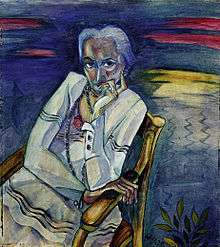Rosa Schapire

Rosa Schapire (September 9, 1874 – February 1, 1954) was a Polish-born art historian who lived in Germany and England.[1] She was a model and art owner who gave early recognition to the Die Brücke group of artists.
Life
The daughter of wealthy Jewish parents, she was born in Brody and was educated by private tutor. In 1893, she moved to Hamburg. In 1897, she published Ein Wort zur Frauenemanzipation (A word on women’s emancipation). She studied art history, receiving an undergraduate degree from the University of Bern in 1902 and going on to earn a PhD from Heidelberg University in 1904. Schapire pursued post-graduate studies at Leipzig University.[2][3]
After her return to Hamburg in 1908, she worked at translation and publishing criticism. She translated Balzac, Zola and the Polish art historian Kazimierz Chledowski into German. She gave early recognition to the Die Brücke group of artists.[2] She helped found the Frauenbund zur Förderung deutscher bildenden Kunst (Women’s Society for the Advancement of German Art) in 1916.[2][3]
Schapiro was herself a model for different painters. Karl Schmidt-Rottluff of the Brücke group made several portraits of her including one in 1919.[4] Walter Gramatté painted her in 1920.[3] In 1924, she published a catalogue of Karl Schmidt-Rottluff's graphic works.[2]
In 1939, she was able to escape Nazi-dominated Germany for England. There, she contributed to various art journals, such as Architectural Review, Eidos, Connoisseur and Die Weltkunst. She also assisted Nikolaus Pevsner with collection of material for his series The Buildings of England.[3]
She died in the Tate Museum in 1954.[2]
Her attempt to donate part of her collection to British museums while she was alive was not well-received and she donated the bulk of her art collection to museums in Germany: Mannheim, Berlin, Altona, Hamburg and Cologne. Other works were sent to museums in Holland, Belgium, Chicago and Tel Aviv[2] with the only British examples available at the Victoria and Albert Museum and Leicester Museum.[3] However, there is one portrait of her by Karl Schmidt-Rottluff in The Tate.[4]
References
- ↑ Gesellschaft, Patriotische (2015). Heine, Dönhoff und die Primus-Katastrophe: Menschen und Ereignisse in Hamburg (in German). p. 102. ISBN 3954005042.
- 1 2 3 4 5 6 "Schapire, Rosa". Dictionary of Art Historians.
- 1 2 3 4 5 "Rosa Schapire 1874 – 1954". Encyclopedia. Jewish Women's Archive.
- 1 2 Dr Rosa Shapiro, Karl Schmidt-Rottluff, Retrieved 19 March 2016